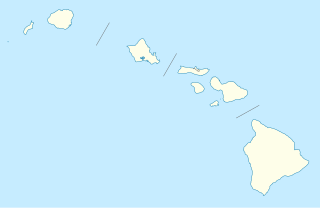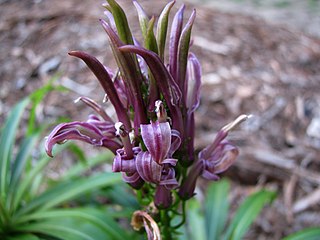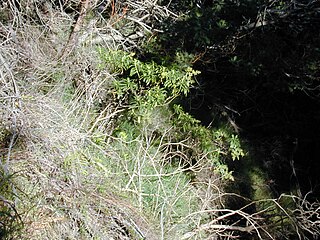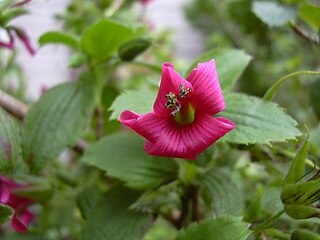
Haleakalā National Park is an American national park located on the island of Maui in the state of Hawaii. Named after Haleakalā, a dormant volcano within its boundaries, the park covers an area of 33,265 acres, of which 24,719 acres is a wilderness area. The land was designated a national park in 1976 and its boundaries expanded in 2005.

The Hawaiian lobelioids are a group of flowering plants in the bellflower family, Campanulaceae, all of which are endemic to the Hawaiian Islands. This is the largest plant radiation in the Hawaiian Islands, and indeed the largest on any island archipelago, with over 125 species. The six genera can be broadly separated based on growth habit: Clermontia are typically branched shrubs or small trees, up to 7 metres (23 ft) tall, with fleshy fruits; Cyanea and Delissea are typically unbranched or branching only at the base, with a cluster of relatively broad leaves at the apex and fleshy fruits; Lobelia and Trematolobelia have long thin leaves down a single, non-woody stem and capsular fruits with wind-dispersed seeds; and the peculiar Brighamia have a short, thick stem with a dense cluster of broad leaves, elongate white flowers, and capsular fruits.

Acacia koaia, known as koaiʻa or koaiʻe in Hawaiian, is a tree in the pea family, Fabaceae, that is endemic to Hawaii. It is closely related to koa, and is sometimes considered to be the same species.

Hosmer's Grove is an example of experimental forestation from Hawaii's territorial days. Located just inside Haleakala National Park near the summit of Haleakala in Maui, Hawaii, it includes a campsite and several hiking trails. The grove is well known amongst birdwatchers due to the abundance of endemic honeycreepers at the site, including Iiwi, Apapane, Hawaii Amakihi, and the Maui Alauahio.

Lipochaeta, common name nehe, is a genus of flowering plants in the daisy family, Asteraceae that is endemic to Hawaii.

Melanthera, squarestem, is a genus of flowering plants in the daisy family, Asteraceae, native to North and South America, as well as Africa, Asia and Oceania, including Hawaiʻi.
Udea despecta, the Hawaiian sweetpotato leafroller, is a moth of the family Crambidae. It is endemic to the Hawaiian islands of Kauai, Oahu, Molokai, Maui, Lanai and Hawaii.
Philodoria lipochaetaella is a moth of the family Gracillariidae. It was first described by Otto Swezey in 1940. It is endemic to the Hawaiian island of Maui.
Cyanea mceldowneyi is a rare species of flowering plant in the bellflower family known by the common name McEldowney cyanea. It is endemic to Hawaii, where it is known only from the island of Maui. A 2007 count estimated 60 plants remaining in two populations. It was federally listed as an endangered species of the United States in 1992. Like other Cyanea it is known as haha in Hawaiian.

Dubautia plantaginea is a rare species of flowering plant in the aster family known by the common name plantainleaf dubautia. It is endemic to Hawaii where it is the only member of the silversword alliance that is found on all six of the largest islands. Two of the three subspecies are rare and endangered. Like other Dubautia this plant is called na`ena`e.

Geranium arboreum is a rare species of geranium known by the common names Hawaiian red-flowered geranium and Hawaii red cranesbill. It is endemic to Hawaii, where it is known only from the island of Maui. It was federally listed as an endangered species in 1992. Like other Hawaiian geraniums, this plant is known as hinahina and nohoanu.

Kadua coriacea is a rare species of flowering plant in the coffee family known by the common name kioʻele. It is endemic to Hawaii, where it is known only from the island of Hawaiʻi and one individual remaining on Maui. It is a federally listed endangered species of the United States.

Melanthera fauriei, known by the common name Olokele Canyon nehe, is a rare species of flowering plant in the aster family.

Lipochaeta lobata is a species of flowering plant in the aster family known by the common name shrubland nehe. It is endemic to Hawaii, where it can be found in coastal dry shrublands and dry forests on Oʻahu, Maui, and Niʻihau.

Melanthera micrantha, known by the common name Kauai nehe, is a rare species of flowering plant in the aster family.

Melanthera tenuifolia is a rare species of flowering plant in the aster family known by the common names Waianae Range nehe and slender-leaf nehe.
Melanthera venosa is a rare species of flowering plant in the aster family known by the common name spreading nehe. It is endemic to Hawaii, where it is known only from the island of Hawaii. It is federally listed as an endangered species of the United States.
Melanthera waimeaensis is a rare species of flowering plant in the aster family known by the common name Waimea Canyon nehe. It is endemic to Hawaii, where it is known only from the island of Kauai. It is federally listed as an endangered species of the United States.
Platanthera holochila is a rare species of orchid known by the common name Hawaii bog orchid. It is endemic to Hawaii. It is a federally listed endangered species of the United States.
Remya mauiensis is a rare species of flowering plant in the aster family known by the common name Maui remya. It is endemic to Hawaii, where it is known only from the island of Maui. It is threatened by the degradation of its habitat. It is a federally listed endangered species of the United States.













